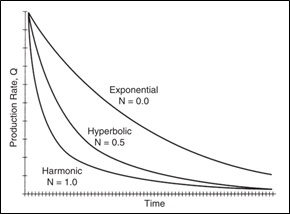Economic Feasibility Analysis of Fishing Job Operation in Well YS13
DOI:
https://doi.org/10.25299/jgeet.2022.7.4.10190Keywords:
Fishing Job, Decline Curve, Economic Fishing Time (EFT), NPV, IRRAbstract
Oil consumption in Indonesia has increased from year to year. However, the increasing demand for oil and natural gas is inversely proportional to oil and gas production, which always declines from year to year. One of the factors causing the decline in production is the well damage. Well YS13 is a well that is damaged in the form of fish in the well. A fishing job is the most appropriate option to solve the problem of the presence of fish in the well because the fish in the well must be removed to continue well production activities or drilling activities. This study aimed to determine the economic feasibility of fishing job activities to be carried out at the YS13 well. The research begins with the preparation of the required data, then calculate the predicted production of the YS13 well with the decline curve method, estimates the cost of the fishing job, and economic fishing time (EFT). And determines the economic feasibility of the fishing job project by calculating profit indicators, namely Net Present Value (NPV), Internal Rate of Return (IRR), and Pay Out Time (POT). The results of calculations using the decline curve method obtained that the total production for 20 months is 4293.52 bbl. The EFT value is 3 days with Ps = 10% and the total cost of fishing is $28.657,70. The economic value of the project with discount rate = 12%, MARR = 12%, NPV = $147.367,20, IRR = 114%, and POT = 1.44. From the results of the calculation of the economic feasibility, the project is considered feasible to be carried out.
Downloads
References
Adkins, C. S. (1993) ‘Economics of fishing’, JPT, Journal of Petroleum Technology, 45(5), pp. 402–404.
Ariyon, M., Setiawan, A. and Reza, R. (2020) ‘Economic Feasibility Study of Onshore Exploration Oil Field Development using Gross Split Contract Economic Feasibility Study of Onshore Exploration Oil Field Development using Gross Split Contract’, IOP Conference Series: Materials Science and Engineering.
Cunha, J. C. S. (1994) ‘Risk analysis theory applied to fishing operations: a new approach on the decision-making problem’, pp. 551–560.
Degeare, J. (2015) The guide to oilwell fishing operations : tools, techniques, and rules of thumb. 2nd edn, Gulf Professional Publishing. 2nd edn. Oxford.
Drs. M. Giatman (2006) Ekonomi Teknik. Edited by A. Aliludin. Jakarta: PT Raja Grafindo Persada.
Erziyanti, M. O. (2019) Kerjasama Indonesia-Tiongkok Di Sektor Migas (Studi Kasus: Joint Operating Body Pertamina-Petrochina East Java Di Blok Tuban Dalam Meningkatkan Produksi Minyak Periode 2012-2017), Universitas Pembangunan Nasional Veteran. Universitas Pembangunan Nasional Veteran.
Fiqri, A. ; S. I. (2013) ‘Analisis Keekonomian Psc No Cost Recovery Dan Pengaruh Penggunaan Sliding Scale Share Before Tax Pada Pengembangan Lapangan Cbm “Z” Di Cekungan Kutai’, Ahmad Fiqri dan Syamsul Irham, 53(9), pp. 1689–1699.
Irwin, R. W. (2015) ‘Penentuan Isi Awal Minyak dan Peramalan Produksi-nya dengan Decline Curve Analysis di Lapangan “R”’, Seminar Nasional Cendekiawan 2015, pp. 411–421.
Kemp, G. (1986) Oilwell Fishing Operations : Tools and Techniques. Houston: Gulf Publishing Company.
Lyons, W. C. and Plisga, G. J. (2005) Standard Handbook of Petroleum & Natural Gas Engineering. 2nd edn. Oxford: Gulf Professional Publishing.
Lyons, W. C., Plisga, G. J. and Lorenz, M. D. (2015) Standard Handbook of Petroleum and Natural Gas Engineering. Third, Standard Handbook of Petroleum and Natural Gas Engineering. Third. Oxford: Gulf Professional Publishing.
Novrianti, N. (2017) ‘Studi Kelayakan Pekerjaan Pemilihan Zona Produksi dan Squeeze off Cementing pada Sumur MY05’, Journal of Earth Energy Engineering, 6(2), pp. 1–8.
Pertamina (2015) Keekonomian Fishing Sumur R. Aceh Tamiang: Report PT. Pertamina Hulu Rokan Zona 1 Field Rantau.
Rahman, H. and Damayanti, S. M. (2021) ‘Financial Feasibility Study of Oil and Gas Well in Indonesia Case Study: New Oil and Gas Well in PT ABC’, European Journal of Business and Management Research, 5(6), pp. 1–9.
Rukmana, D. and Kristanto, D. (2011) Teknik Reservoir : Teori dan Aplikasi. Yogyakarta: Pohon Cahaya.
Sari, N. (2011) Ekonomi Teknik. Surabaya: Yayasan Humaniora.
Shereih, K. (2017) Economics Modeling for Petroleum Exploration and Production Projects Considering Risk and imprecise Data. Berlin: Technischen Universität Berlin.
Taher, W. P. (2019) ‘Langkah Strategis Meningkatkan Produksi Minyak Bumi’, Bulletin SKK Migas.
Utama, E. R. (2014) ‘Analisis Faktor-Faktor Yang Mempengaruhi Impor Minyak Mentah Di Indonesia’, Journal of Economics and Policy, 7(1), pp. 85–91.
Wibisono, K. (2018) ‘Pengelolaan Lapangan “Tua” Studi Kasus Lapangan Sembakung, Kalimantan Utara’, Prosiding Seminar Nasional Cendekiawan, pp. 423–428.
William, Kartoatmodjo, T. and Prima, A. (2017) ‘Studi Kelayakan Keekonomian Pada Pengembangan Lapangan’, Seminar Nasional Cendekiawan, pp. 273–278.

Downloads
Published
Issue
Section
License
Copyright @2019. This is an open-access article distributed under the terms of the Creative Commons Attribution-ShareAlike 4.0 International License which permits unrestricted use, distribution, and reproduction in any medium. Copyrights of all materials published in JGEET are freely available without charge to users or / institution. Users are allowed to read, download, copy, distribute, search, or link to full-text articles in this journal without asking by giving appropriate credit, provide a link to the license, and indicate if changes were made. All of the remix, transform, or build upon the material must distribute the contributions under the same license as the original.










